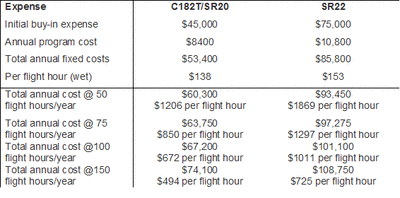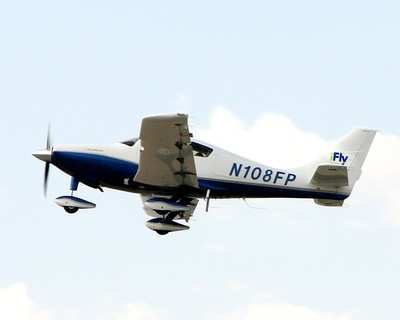Is It The Right Option For You?
By ANN Contributor Thomas P. Turner
 Fractional
ownership.
Fractional
ownership.
This aircraft ownership option has seemingly sprouted almost
from nowhere in the last few years. Although fractional ownership
of professionally flown turbine aircraft appeared a few years
earlier, the rise of owner-flown fractional ownerships began
concurrently with the introduction of what we now call Technically
Advanced Aircraft (TAA)--airplanes with moving-map GPS and
autopilot technology, more and more frequently with "glass cockpit"
Primary Flight Display (PFD)/Multifunction Display (MFD)
panels.
Does fractional ownership make sense to pilots who fly
piston-powered airplanes? What are the deciding points on buying
into a fractional? What are the unique benefits of fractionals that
offset some of the costs? When are you ahead of the game to bypass
fractionals and buy an airplane outright? What might you consider
to decide whether fractional ownership makes sense for you?
To answer these questions ANN has spent several months
researching fractional ownership of owner-flown, piston-powered
airplanes. We've surveyed readers like you who are fractional
owners, who are currently considering buying into a fractional
program, or have been fractional owners but have left the program
for one reason or another. We've also polled managers of
fractionals. With this cross-section, we got a sense of each
perspective toward fractional ownership of owner-flown piston
airplanes-you'll see quotes from several ANN readers' responses as
you read this report.
Typical program costs
Entry into fractional programs, as we've seen, comes at several
levels. Most members seem to gravitate toward 1/8 equity
partnerships. Within that framework, here are some sample costs for
the first year of flying in a fractional ownership program:

In subsequent years (after the up-front buy-in cost) the total
costs range from $306 per flight hour (@50 hrs/yr) to $194 per
flight hour (@150 hrs/yr) for the C182T/SR20, and $369 per flight
hour (@50 hrs/yr) to $225 per flight hour (@150 hrs/yr) for the
SR22. Or if you prefer to average the buy-in cost over the
four-year contract the approximate hourly costs are:

"You have to pay a lot (too much) money for professional
management of the aircraft." -- Current fractional owner
Obviously the per-hour flight cost of fractional ownership is
far greater than traditional airplane rentals through FBOs. The
advantage, of course, is that fractional airplanes are typically
much more capable, newer, better equipped, and better maintained
than the average rental airplane. Add the services provided by
fractional managers and, as long as you're flexible with
scheduling, fractional ownership plans may be far more attractive
than outright ownership.

"I think a prospective fractional owner needs to very
carefully consider the limitations imposed on ownership, and as the
organization grows how costs can increase to the point where owning
outright will probably outweigh a fractional ownership." --
Current fractional owner
Getting out
Fractional ownership, especially in equity positions, is a
time-based contract. Usually the term is four years. To keep
nearly-new airplanes in the program, most plan on selling the
equity airplane after four years and replacing it with a similar
type. Equity owners share in the proceeds of the sale and can
depart the program or enter into a new fractional agreement-either
in the same type of airplane being replaced or, if available,
moving up to a more capable aircraft.
"At the end of my 4-year term, I renewed for another four
years. I am flying a nearly brand new airplane. They are better
maintained than the rental planes I have flown. I love the SR22,
and my passengers seem to love it as much as I do." -- Current
fractional owner
During the term of most program contracts fractional owners can
advertise and sell their equity, selling to new owners who pick up
the agreement where the seller left off. In fact, some fractional
managers will broker the position for the departing member for a
percentage of the selling price. In practice a fractional equity
position is less like a condominium time-share and more like
outright ownership, with individuals able to sell their way out at
any time.

Fractional ownership -- The biggest surprise
The biggest surprise for me about fractional ownership is the
financial commitment. Before taking an in-depth look at the
fractional option, I assumed that fractional ownership was more
like expensive renting that lower-cost ownership, similar to
flying-club costs albeit a little higher because of newer
equipment. But as AirShares states on its website, fractional
ownership costs about 1/3 the expense of outright ownership, which
is more than the "fraction" of the airplane you own because of your
costs for the additional benefits of program management.

As we've heard from many survey respondents, the most commonly
cited positive part of the fractional experience is the ability to
fly a current-production airplane for less than what it costs
outright. But few of those respondents said they could not afford
to buy the new airplane outright if they'd wanted to -- it was a
matter of getting most of what they wanted for a (large) fraction
of the cost, or buying into fractional ownership of a late-model
airplane in lieu of outright purchase of something just a little
older. Many fractional owners had owned all or part of a
high-performance airplane in the past.
In other words, fractional ownership does not make very many
airplane owners out of renters; instead, it seems to be a purchase
option with additional features like airplane management for
financially qualified pilots already in the airplane-buying mode. I
found that surprising, contrary to my expectation, but it's fairly
obvious if you start plugging buy-in price, monthly fees and hourly
operating costs into a spreadsheet. Great bargains though they are
for flying a new-production aircraft, fractional ownerships are not
a "low cost" way to own an airplane... instead, they're a lower
cost way to own a nearly-new airplane.
Coming Saturday: So, Is Fractional Ownership For
You?
 Airbus Racer Helicopter Demonstrator First Flight Part of Clean Sky 2 Initiative
Airbus Racer Helicopter Demonstrator First Flight Part of Clean Sky 2 Initiative Diamond's Electric DA40 Finds Fans at Dübendorf
Diamond's Electric DA40 Finds Fans at Dübendorf ANN's Daily Aero-Term (04.23.24): Line Up And Wait (LUAW)
ANN's Daily Aero-Term (04.23.24): Line Up And Wait (LUAW) NTSB Final Report: Extra Flugzeugbau GMBH EA300/L
NTSB Final Report: Extra Flugzeugbau GMBH EA300/L Classic Aero-TV: 'Never Give Up' - Advice From Two of FedEx's Female Captains
Classic Aero-TV: 'Never Give Up' - Advice From Two of FedEx's Female Captains








